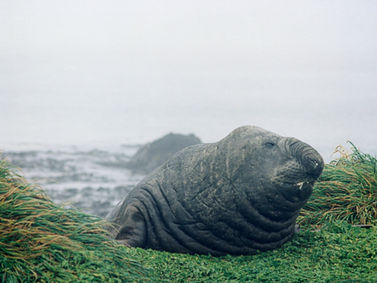
Macquarie Island
On a tiny spec of land in the Southwestern Pacific Ocean is the UNESCO World Heritage Site of Macquarie Island. The UNESCO World Heritage Listing in 1997 recognises the island’s conservation significance, being the only place on earth where rocks from the earth's mantle are actively exposed above sea level.
Discovered in 1810 by Frederick Hasselborough, the island became the home for sealers who slaughtered, almost to extinction, the island’s seal and penguin population for their oil in less than a decade. Relics, such as old sealers huts, island try-pots, casks and graves, of those bygone days remain on the Macquarie Island isthmus.
Macquarie Island is located about halfway between Tasmania and New Zealand. The 1552-kilometre journey from Hobart, Tasmania, takes about two days, depending on the weather conditions, by a ship travelling around 20 knots. The ocean waters around Macquarie Island can be brutally rough, making the journey a test even for the most seasoned sailors.
The Island has an area of approximately 128 square kilometres and is about 34 kilometres long and 5 kilometres wide. Macquarie’s topography consists of highlands rising up to 400 metres, for most of the southern end of the island and Radio Hill elevation of about 40 metres, on the northern tip of the island. Radio Hill is linked to the southern island by a narrow isthmus, which is only 1.5 metres above sea level.
The human population on Macquarie is minimal, ranging from 20 to 40 persons who live predominately in the station accommodation located on the isthmus. In addition to the accommodation, the station also has research facilities and workshops.

Macquarie Island is brimming with sub-Antarctic wildlife.
The island has about 13 species of seabirds with an estimated population of 3.5 million individuals. The primary birds are the Royal, King, Gentoo, and Rockhopper penguins. Some of the largest penguin rookies in the world are found on Macquarie Island.
Other bird species include the Macquarie shag, Wandering Albatross, Sooty Albatross, Grey Headed Albatross, Black Browed Albatross, petrels, prions, kelp gulls, great skuas, shearwaters, terns and endemic Macquarie Island cormorants.
Seals also inhabit Macquarie Island. The species include the Antarctic, sub-Antarctic and New Zealand fur seals and the Southern Elephant seals, an estimated 80,000 individuals.
Whales are also seen in the waters around Macquarie Island. The most common whale in the region is the Orca (Killer Whales). Sothern-right, Sperm and Pilot Whales also swim close to the island.

Why include Macquarie Island on a Tasmanian website?
The simple answer is Macquarie Island is officially a part of Tasmania. To explain, a little history.
When the Australian, Frederick Hasselborough, discovered and named Macquarie Island, he claimed the island for Britain and annexed it to the colony of New South Wales in 1810.
On 17 June 1890, the island was transferred from New South Wales to Tasmania.
In 1911, the island became a base for the Australasian Antarctic Expedition under Sir Douglas Mawson and operated as Mawson’s base for three years.
In 1933, the Tasmanian Government declared Macquarie Island a wildlife sanctuary under the Tasmanian Animals and Birds Protection Act 1928. The Government declared the island a State Reserve under the Tasmanian National Parks and Wildlife Act 1970 in 1972.
On 25 May 1948, the Australian National Antarctic Research Expeditions (ANARE) established its expedition headquarters on Macquarie Island. The station is managed by the Australian Antarctic Division, which is located in Kingston, Tasmania.



















